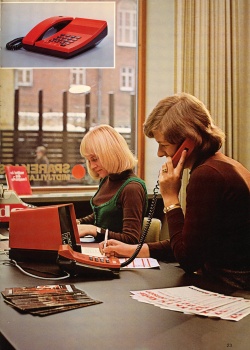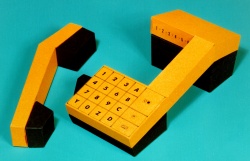76 E
01. Sep. 2004

Jydsk Telefon's "poor man's terminal" to be used in small savings bank branches were based on the 76 E telephone and a small display unit with a microprocessor.
Photo: TDC's Museum Archives.
The development of the telephone began in 1974 in collaboration with Standard Electric Kirk. Project manager was head of Jydsk Telefon's laboratory, Kurt Vestergaard, who became managing director of the company in 1982. The intention was not only to offer the subscribers (yet) another telephone, but to produce and market what was describet as the "telephone of the future". A fully electronic telephone was already being developed with the large international manufacturers, but not many people saw a market for an actural massproduction. This was not the attitude of Jydsk Telefon where they had an eye on the export market possibilities.
Telephone of the Future
As a designer the choice fell upon Jacob Jensen, who was known for his work for the Jutlandish producer of radio and TV equipment, B&O. From the very beginning it was the intention that design and technique should compose a unity: Therefore the horizontal keyboard and the extra push-buttons enabling the use of the telephone as a data terminal.

Jacob Jensen's first proposal for the telephone of the future was rejected as it looked like a four-winged farm. Photo: TDC's Museum Archives.
Jydsk Telefon became the first telephone company in the world to offer its subscribers a fully electronic push-button apparatus with tone keyboard as a standard. In addition, the telephone was made in an infinitude of variants with built-in answering machine, calculator, exchange etc. intended for companies, organisations, and public institutions.
Moreover, the telephone was used in connection with a special data terminal which the savings bank, SDS, started using in 1976. Whilst the 76 E was used in the bank's local branches as a "sending terminal" to a central mainframe computer, a small data screen functioned as a "receiving terminal".
However, it was as a telephone in hundreds of thousands private homes that the 76 E became known and won fame. Besides the subscribers of Jydsk Telefons it became a huge export success.
Even today the 76 E telephone can still be found in many homes. And it can be seen in the world-famous Museum of Modern Art in New York where it has a permanent place in the exhibition.
This article may be copied or quoted with MuseumsPosten, Post & Tele Museum as source.
Comment this article
Only serious and factual comments will be published.